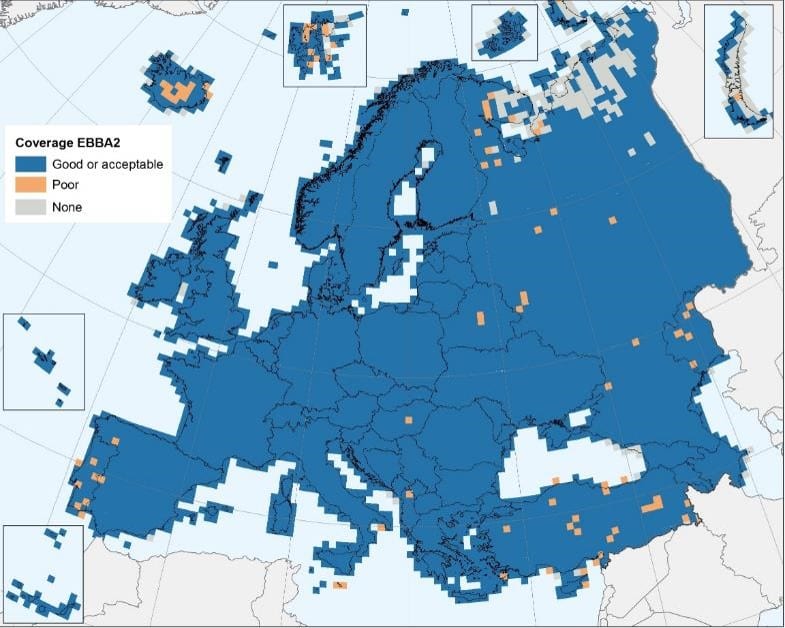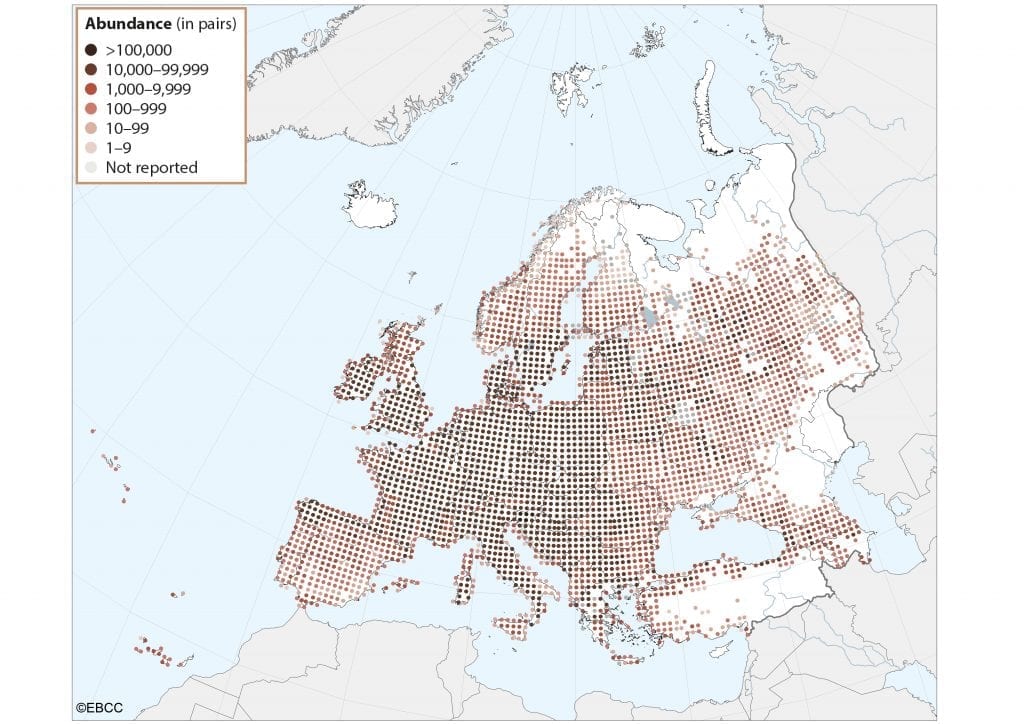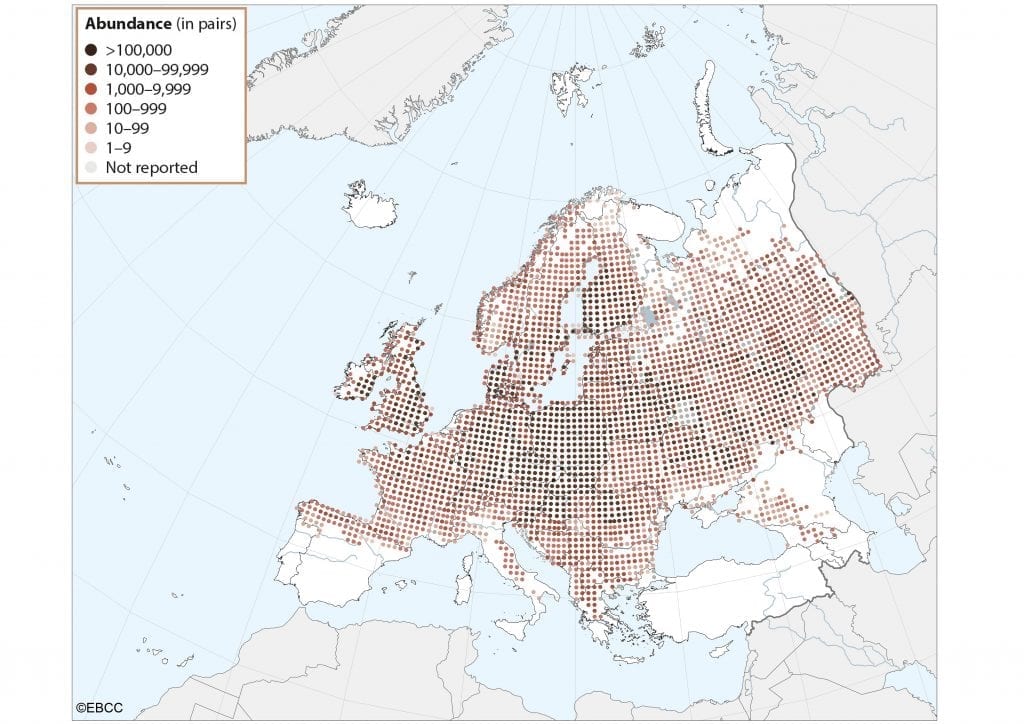BirdWatch Ireland are proud to have contributed to the landmark ‘European Breeding Bird Atlas 2’, which was published today (3rd December 2020).
The book represents a new milestone in European ornithology, charting the breeding distribution of 596 bird species across 48 countries. It has been 30 years since the first European Breeding Bird Atlas. There have been significant changes in habitat across European landscapes since that time, not to mention a rapidly changing climate, and the breeding distributions of bird populations have changed as a result. Although there are species shifting their distribution in various directions, it appears that a northward expansion is a trend often detected.

Coverage achieved for the upcoming landmark publication ‘European Breeding Bird Atlas 2’.
A total of 5,110 50*50km squares were surveyed (7% of the earths land cover!), gathering information on location, date and breeding status of each species encountered. The atlas revealed that 539 native bird species and 57 non-native species have bred in Europe during the period 2013–2017. Some are widespread and were found in almost all 50x50km squares, other species occur in Europe only in restricted areas and were found in few squares.
More than 50% of the species occurred in less than 10% of all surveyed squares, highlighting the fragility of some of our most beloved and important bird species. It also emphasises the responsibility that every country has to deliver effective and targeted conservation efforts to ensure populations of these species are maintained and enhanced so that they are present for generations to come. An increase in the range of many non-native species in Europe was also detected in the EBBA2 outputs, which may pose conservation challenges in the future.
Breeding distribution of the Eurasian Blackcap across Europe in the new ‘European Breeding Bird Atlas 2’.
“This atlas really is a phenomenal resource and we’re hugely grateful to the huge number of Irish birdwatchers who contributed records, allowing us to put Ireland’s breeding bird populations into a European context.” said BirdWatch Ireland’s Brian Burke, one of the Atlas coordinators in Ireland. “We’ve seen some significant changes in Ireland since the last European Breeding Bird Atlas survey work was done, including the natural re-colonisation of the Buzzard and Great Spotted Woodpecker, the reintroduction of Red Kites, Golden Eagles and White-tailed Eagles, the expansion of the breeding range of the Great Skua around the north and west coasts, and the rapid spread of the Little Egret across wetlands all over Ireland since the mid-1990’s. Conversely though, many of our breeding waders including Curlew, Lapwing and Redshank have lost a lot of ground and may not be around for the next atlas in 30 years time if we don’t make the necessary changes to the Irish landscape. The map for Roseate Tern, the rarest breeding seabird in Europe whose two most important colonies are in Dublin and Wexford, shows that our conservation efforts here in Ireland can bear fruit if we stick with it. There’s no reason the story for Curlew and others in 30 years time can’t be a good news story if we act now.”
Breeding distribution of the Yellowhammer across Europe in the new ‘European Breeding Bird Atlas 2’.
Birds don’t recognise national borders, and to achieve this level of international cooperation required a huge effort from conservation organisations and dedicated ornithologists across Europe. In total, around 120,000 fieldworkers contributed breeding bird data from virtually all corners of Europe, covering 96% of the continent. The majority of contributors did so voluntarily, making this one of the biggest citizen science projects on biodiversity ever. The efforts of volunteer birdwatchers have always been crucial to the monitoring and conservation of birds in Ireland, through participation in surveys such as the Irish Wetland Bird Survey, Countryside Bird Survey, Irish Garden Bird Survey and other monitoring projects. These volunteers give up their time and expertise to help ensure the protection of the birds and wildlife in their local area and their efforts are vital to conservation efforts in Ireland abroad. Work for the atlas has further strengthened the links between organisations and dedicated ornithologists across Europe, providing a sound knowledge basis for future cooperation at international level.
The European Breeding Bird Atlas 2 is now available for purchase via the link below.
https://www.lynxeds.com/product/european-breeding-bird-atlas-2-distribution-abundance-and-change/
For more information about the European Breeding Bird Atlas 2 project, visit https://www.ebba2.info/





